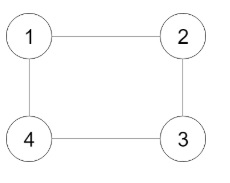How to Clone a Graph in C++/Java using Depth First Search Algori
- 时间:2020-10-11 15:48:46
- 分类:网络文摘
- 阅读:132 次
Given a reference of a node in a connected undirected graph, return a deep copy (clone) of the graph. Each node in the graph contains a val (int) and a list (List[Node]) of its neighbors.
clone-graph-algorithm
Input:
{"$id":"1","neighbors":[{"$id":"2","neighbors":[{"$ref":"1"},{"$id":"3","neighbors":[{"$ref":"2"},{"$id":"4","neighbors":[{"$ref":"3"},{"$ref":"1"}],"val":4}],"val":3}],"val":2},{"$ref":"4"}],"val":1}Explanation:
- Node 1’s value is 1, and it has two neighbors: Node 2 and 4.
- Node 2’s value is 2, and it has two neighbors: Node 1 and 3.
- Node 3’s value is 3, and it has two neighbors: Node 2 and 4.
- Node 4’s value is 4, and it has two neighbors: Node 1 and 3.
Note:
- The number of nodes will be between 1 and 100.
- The undirected graph is a simple graph, which means no repeated edges and no self-loops in the graph.
- Since the graph is undirected, if node p has node q as neighbor, then node q must have node p as neighbor too.
- You must return the copy of the given node as a reference to the cloned graph.
C++ Algorithm to Clone a Unidirectional Graph
Since the graph is unidirectional, it can also be seen as bi-directional. A’s neighbors contain B and B’s neighours contain also A. By using DFS (Depth First Search), we have to solve the loop problem – which is to avoid cloning the same node again and again.
The solution is easy: to use the hash map, that remembers the mappings between source nodes and the cloned nodes.
1 2 3 4 5 6 7 8 9 10 11 12 13 14 15 16 17 18 19 20 21 22 23 24 25 26 27 28 29 30 31 32 33 34 | /* // Definition for a Node. class Node { public: int val; vector<Node*> neighbors; Node() {} Node(int _val, vector<Node*> _neighbors) { val = _val; neighbors = _neighbors; } }; */ class Solution { public: Node* cloneGraph(Node* node) { if (node == NULL) return NULL; if (copied.find(node) != copied.end()) { // already cloned return copied[node]; } vector<Node*> nbs = {}; Node* root = new Node(node->val, nbs); copied[node] = root; // mark it cloned first to avoid stack overflow. for (const auto &n: node->neighbors) { root->neighbors.push_back(cloneGraph(n)); // clone the neighboured recursively } return root; } private: unordered_map<Node*, Node*> copied; }; |
/*
// Definition for a Node.
class Node {
public:
int val;
vector<Node*> neighbors;
Node() {}
Node(int _val, vector<Node*> _neighbors) {
val = _val;
neighbors = _neighbors;
}
};
*/
class Solution {
public:
Node* cloneGraph(Node* node) {
if (node == NULL) return NULL;
if (copied.find(node) != copied.end()) { // already cloned
return copied[node];
}
vector<Node*> nbs = {};
Node* root = new Node(node->val, nbs);
copied[node] = root; // mark it cloned first to avoid stack overflow.
for (const auto &n: node->neighbors) {
root->neighbors.push_back(cloneGraph(n)); // clone the neighboured recursively
}
return root;
}
private:
unordered_map<Node*, Node*> copied;
};The above C++ algorithm to clone graphs take O(N) complexity in both time and space where N is the number of nodes in the graph.
Java Recursive Algorithm (DFS) to clone graph
Same algorithm (in recursion) can be implemented in Java as follows. The neighbour nodes are cloned by using Depth First Search recursion.
1 2 3 4 5 6 7 8 9 10 11 12 13 14 15 16 17 18 19 20 21 22 23 24 25 26 27 28 29 | /* // Definition for a Node. class Node { public int val; public List<Node> neighbors; public Node() {} public Node(int _val,List<Node> _neighbors) { val = _val; neighbors = _neighbors; } }; */ class Solution { public Node cloneGraph(Node node) { if (copied.containsKey(node)) { // graph node cloned already return copied.get(node); } Node root = new Node(node.val, new ArrayList<Node>()); copied.put(node, root); // mark it cloned to avoid duplication for (Node n: node.neighbors) { root.neighbors.add(cloneGraph(n)); // clone the neighbours recursively } return root; } private HashMap<Node, Node> copied = new HashMap<>(); } |
/*
// Definition for a Node.
class Node {
public int val;
public List<Node> neighbors;
public Node() {}
public Node(int _val,List<Node> _neighbors) {
val = _val;
neighbors = _neighbors;
}
};
*/
class Solution {
public Node cloneGraph(Node node) {
if (copied.containsKey(node)) { // graph node cloned already
return copied.get(node);
}
Node root = new Node(node.val, new ArrayList<Node>());
copied.put(node, root); // mark it cloned to avoid duplication
for (Node n: node.neighbors) {
root.neighbors.add(cloneGraph(n)); // clone the neighbours recursively
}
return root;
}
private HashMap<Node, Node> copied = new HashMap<>();
}Similarly, we can use such algorithms to clone (deep copy) a binary tree: Clone (Deep Copy) Binary Tree With Random Pointer using Hash Map and Recursion
–EOF (The Ultimate Computing & Technology Blog) —
推荐阅读:永州韦使君新堂记原文及翻译 捕蛇者说原文及翻译 报孙会宗书原文及翻译 尚德缓刑书原文及翻译 上书谏猎原文及翻译 狱中上梁王书原文及翻译 论贵粟疏原文及翻译 治安策原文及翻译 过秦论原文及翻译 武帝求茂才异等诏原文及翻译
- 评论列表
-
- 添加评论
